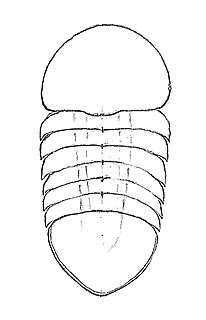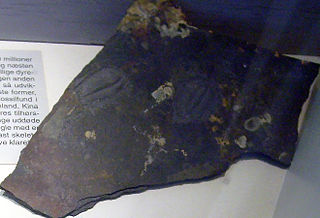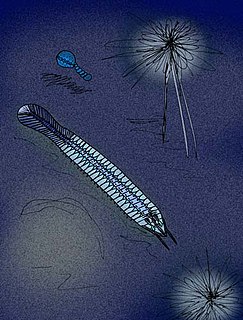 W
WThe Buen Formation is a geologic formation and Lagerstätte in the north of Greenland. The shale preserves fossils dating back to the Early Cambrian period.
 W
WBuenaspis is a genus of small marine arthropods in the family Liwiidae, that lived during the early Cambrian period. Fossil remains of Buenaspis were collected from the Lower Cambrian Sirius Passet Lagerstätte of North Greenland. Buenaspis looks like a soft eyeless trilobite. It has a headshield slightly larger than the tailshield (pygidium), and in between them six thoracic body segments (somites). The genus is monotypic, its sole species being Buenaspis forteyi.
 W
WBuenellus higginsi is an average size trilobite, which lived during the Lower Cambrian period, in what is now North-West Greenland. It is a prominent member of the Sirius Passet fauna. Buenellus higginsi is the only known species in the genus Buenellus.
 W
WAaveqaspis is a genus of small marine arthropods of unclear affiliation, that lived during the early Cambrian period. Fossil remains of Aaveqaspis were collected from the Lower Cambrian Sirius Passet fossil-Lagerstätte of North Greenland. Aaveqaspis looks like a soft eyeless trilobite with a weakly defined axis, a headshield with stubby genal spines, 5 thorax segments also ending in stubby genal spines, and a tailshield (pygidium) with a pair of massive tusk-like spines, and two smaller spines near the end of the axis. The only species presently known is A. inesoni.
 W
WKerygmachela kierkegaardi was a gilled lobopodian from the Buen Formation of the Sirius Passet Lagerstätte, in northern Greenland. Its anatomy strongly suggests that it, along with its relative Pambdelurion whittingtoni, was a close relative of anomalocaridid (radiodont) and euarthropod. The specific name, "kierkegaardi" honors Danish philosopher Søren Kierkegaard.
 W
WKleptothule rasmusseni is a small, elongated trilobite, about 3 cm in length, and about 5 to 6 mm in width, from the Sirius Passet Lagerstätte. It is currently placed in the family Nevadiidae, though this may change with further study.
 W
WPhragmochaeta canicularis is an extinct animal belonging to the annelids and lived in the Early Cambrian. Fossils have only been found in the Buen Formation at the Sirius Passet Lagerstätte, Greenland and the animal is probably the first polychaete.
 W
WTamisiocaris is an anomalocaridid taxon initially only known from frontal appendages from the Buen Formation in Sirius Passet. Further specimens revealed that the frontal appendages were segmented and bearing densly-packed auxiliary spines, which were adapted to suspension feeding in a manner analogous to modern baleen whales.
 W
WWaptia fieldensis is an extinct species of arthropod from the Middle Cambrian Burgess Shale Lagerstätte of Canada. It grew to a length of about 8 cm (3 in) and resembled modern shrimp in both morphology and habit. It had a large bivalved carapace and a segmented body terminating into a pair of tail flaps. It was an active swimmer, feeding on organic particles it gathered from the seafloor substrate. It is also one of the oldest animals with direct evidence of brood care.